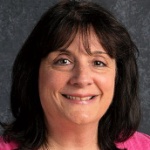A Recurring Theme for Mathematics Instruction

RoseMary Hunt
Math Teacher, Turtle Lake Elementary, Shoreview
Math Instructional Coach, Mounds View Schools
MCTM Region 4 Director
I attended the NCTM regional conference in Minneapolis in mid-November. As I reflected on the sessions I attended, I kept coming back to a recurring theme: The focus of instruction needs to primarily be on building understanding of the structure of mathematics.
I came back home and pulled out my copy of NCTM’s publication, Principles to Actions: Ensuring Mathematical Success for All, and re-read the 8 Mathematics Teaching Practices. The ones that jumped out related to the theme are:
#3: Use and connect mathematical representations
#6: Build procedural fluency from conceptual understanding
Use and Connect Mathematical Representations: refers to the use of a variety of concrete models, drawings, dialog, and written explanations by students. Mathematics is abstract, therefore the use of models is important to help students visualize abstract ideas and to help make connections from one mathematical concept to another. If you think about it, the use of some basic manipulatives progresses to other manipulatives as we “grow the math” with our students. Or we use same manipulatives differently as we move students to the next level.
Let’s try some word association here. Read the mathematical concept and then identify a mathematical representation for it. There may be more than one that you think of.
Making combinations for 10…
Place value…
Commutative property…
Whole number addition or subtraction…
Whole number multiplication or division…
Distributive property…
Fractions less than 1…
Decimal numbers…
Fraction or Decimal number operations…
I’m sure you came up with at least a few.
The visuals allow students to make connections as well as support their understanding of quantities and operations on these quantities. Why are the results when multiplying fraction numbers different than when multiplying whole numbers? A model (manipulative or drawing) can help provide insight as well as justification of the outcomes. Think of the benefits for our English language learners, too.
It is important to select appropriate representations for the concepts being learned by students. Being purposeful in the selection of models and representations need to be coupled with purposeful planning and implementation of tasks. These visuals and tasks provide a platform for students to engage in conversation about their understanding of the mathematical structure of the concept being learned. How might two different visuals represent the same concept? How are they similar? How are they different? Is one better than another?
Build procedural fluency from conceptual understanding: refers to moving toward recording of concepts/skills in efficient and accurate ways without the use of concrete models, pictures, etc. Yet, these models, visuals, etc support the procedures we are moving toward and should be used first. How does the array support multiplication of whole numbers? How does model drawing support multiplication of fractions? How do base-10 blocks support regrouping when adding or subtracting multi-digit numbers?
Sometimes my students are shown ways (procedures or short cuts) outside of the classroom before we tackle them together. I find that once a student knows the procedure, it is very difficult for them to use the model, or even understand the model. They abandon thinking about numbers and sometimes try to fit a procedure where it doesn’t fit. In class today we encountered a problem where the number model was: 5008 – 1279. One student was explaining how we needed to go over to the 5000 to regroup over the place values so there would be enough to subtract place value by place value. So, we took one thousand from 5000, leaving 4000 and moved the 1000 we took (not “borrowed”-we’re not giving it back) to the hundreds place, giving us 10 groups of 100. Another student blurted that we should just make that first 0 a 9….and the next one too. “Why?” I asked. Hmmm, not so sure. Another student said that she checks her regrouping by adding the new groups in each place value of the larger number. So for 5008, she added 4000+900+90+18. Which student has deeper conceptual understanding? Which student can use the visuals or models and apply them to the problem and the procedure?
Fuson and Beckmann (2012/2013) stress the importance of understanding, explaining, and visualizing. As summarized in NCTM’s Principles to Action: “…a standard algorithm is defined by its mathematical approach and not by the way in which the steps in the approach are recorded. They suggest that variations in written notation are not only acceptable but indeed valuable in supporting students’ understanding of the base-10 system and properties of the operations.” (p. 44)
The teaching practices described above (use and connect mathematical representations” and “build procedural fluency from conceptual understanding) work together but don’t put the cart before the horse. Careful and purposeful selection of representations/models and planning tasks that appropriately use these representations/models will give students a stronger foundation in understanding the mathematical structure. This facilitates development of procedural fluency.
